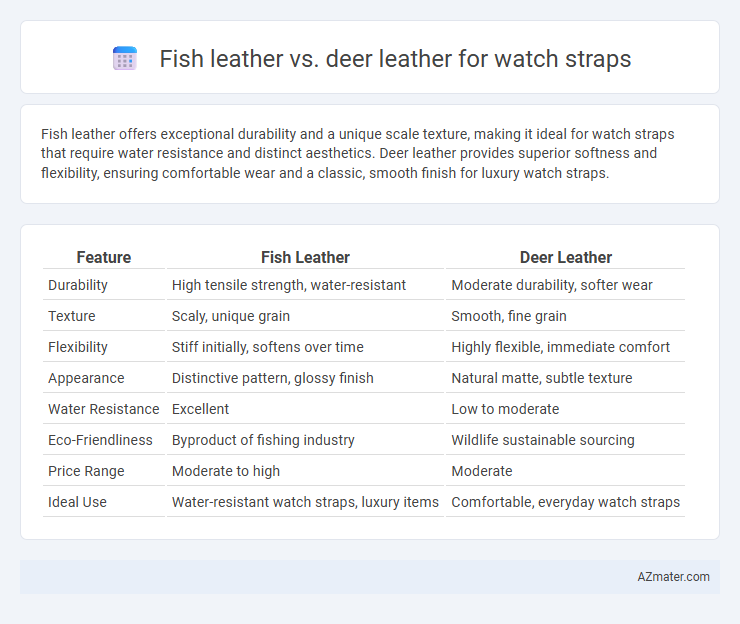Fish leather offers exceptional durability and a unique scale texture, making it ideal for watch straps that require water resistance and distinct aesthetics. Deer leather provides superior softness and flexibility, ensuring comfortable wear and a classic, smooth finish for luxury watch straps.
Table of Comparison
| Feature | Fish Leather | Deer Leather |
|---|---|---|
| Durability | High tensile strength, water-resistant | Moderate durability, softer wear |
| Texture | Scaly, unique grain | Smooth, fine grain |
| Flexibility | Stiff initially, softens over time | Highly flexible, immediate comfort |
| Appearance | Distinctive pattern, glossy finish | Natural matte, subtle texture |
| Water Resistance | Excellent | Low to moderate |
| Eco-Friendliness | Byproduct of fishing industry | Wildlife sustainable sourcing |
| Price Range | Moderate to high | Moderate |
| Ideal Use | Water-resistant watch straps, luxury items | Comfortable, everyday watch straps |
Introduction to Fish Leather and Deer Leather
Fish leather, derived mainly from species like salmon and cod, is prized for its unique scale patterns, lightweight texture, and exceptional durability, making it a sustainable alternative in luxury watch straps. Deer leather, known for its softness, flexibility, and natural grain, offers a supple feel and resilience, commonly favored in traditional leather goods including watch straps. Both materials provide distinct aesthetics and functional properties, appealing to different preferences in watch strap design and performance.
Key Characteristics of Fish Leather
Fish leather for watch straps is known for its exceptional durability and unique texture featuring natural scale patterns that create a distinctive, stylish appearance. It is lightweight, flexible, and highly water-resistant, making it ideal for accessories exposed to moisture. Compared to deer leather, fish leather offers greater tensile strength and a more pronounced grain, providing both aesthetic appeal and long-lasting performance.
Unique Qualities of Deer Leather
Deer leather for watch straps is prized for its exceptional softness, suppleness, and natural grain patterns that offer a distinctive, luxurious feel unmatched by fish leather. Its high tensile strength and durability ensure long-lasting performance, adapting comfortably to wrist movements without losing shape. Unlike fish leather, deer leather exhibits superior breathability and resistance to stretching, making it ideal for premium watch straps that combine elegance with practicality.
Durability Comparison: Fish vs Deer Leather
Fish leather offers remarkable durability due to its tight fiber structure, making it resistant to stretching and tearing, which is ideal for watch straps exposed to frequent wear. Deer leather, while softer and more flexible, tends to develop natural creases over time and may wear down faster with daily use. For longevity and resistance to environmental factors like moisture, fish leather generally outperforms deer leather in watch strap applications.
Comfort and Wearability Factors
Fish leather offers superior breathability and lightweight properties, enhancing overall comfort for watch straps during extended wear. Deer leather provides exceptional softness and flexibility, conforming well to wrist contours for improved wearability. Both materials exhibit durability, but fish leather's unique texture resists moisture better, making it ideal for active users.
Environmental Impact and Sustainability
Fish leather offers a significantly lower environmental footprint compared to deer leather, as it utilizes byproducts from the fishing industry that would otherwise contribute to waste. The tanning process for fish leather often requires fewer chemicals and less water, enhancing its overall sustainability credentials. Deer leather, sourced from land animals, typically involves greater land use and resource consumption, making fish leather a more eco-friendly option for watch straps.
Style and Aesthetic Appeal
Fish leather offers a unique, textured pattern with a natural shimmer, making watch straps visually striking and suitable for bold, contemporary styles. Deer leather presents a smooth, supple surface with a matte finish, ideal for classic and understated elegance in watch strap designs. Both materials provide distinct aesthetic appeals, with fish leather emphasizing exotic flair and deer leather reflecting timeless sophistication.
Maintenance and Care Differences
Fish leather watch straps require more delicate maintenance due to their thinner fibers and higher moisture sensitivity, needing gentle cleaning with a damp cloth and avoiding prolonged exposure to water to prevent damage. Deer leather, known for its softness and durability, tolerates more robust care routines, including conditioning with leather care products to maintain suppleness and resist cracking. Both materials benefit from regular cleaning and avoiding excessive moisture, but fish leather demands more cautious handling to preserve its unique texture and longevity.
Cost and Market Availability
Fish leather for watch straps generally offers a lower cost compared to deer leather, driven by abundant supply from fish processing industries and less intensive tanning processes. Deer leather tends to be more expensive due to limited availability and the complexity of sourcing, alongside its reputation for durability and unique grain patterns. Market availability of fish leather is expanding, especially in sustainable fashion niches, whereas deer leather remains a traditional choice with stable but more niche demand.
Choosing the Best Leather for Watch Straps
Fish leather offers exceptional durability and water resistance, making it ideal for watch straps exposed to moisture. Deer leather provides a soft, supple texture with natural breathability, enhancing comfort during extended wear. When choosing the best leather for watch straps, prioritize durability for active lifestyles or opt for deer leather's comfort and flexibility for everyday elegance.

Infographic: Fish leather vs Deer leather for Watch strap
 azmater.com
azmater.com